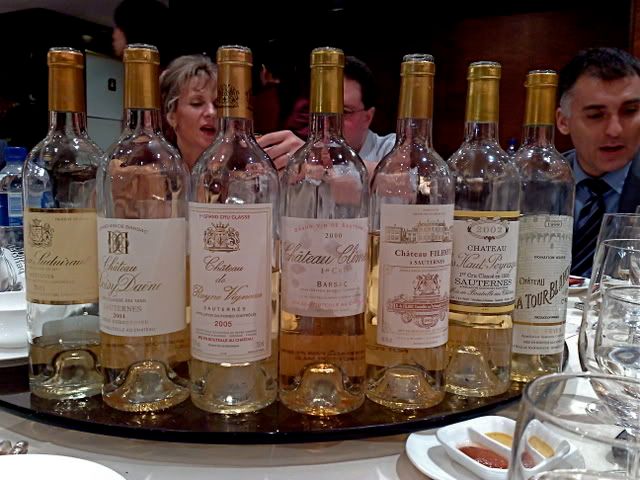“All Sauternes and Barsac with Chinese Food?”
This was the question that came to mind when I found out that Judy Leissner, CEO of Grace Vineyards (China), invited me and my wife (plus 2 other friends) to a Chinese banquet (a.k.a., a “lauriat”) to be paired with 10 wines from Sauternes and Barsac. It was a dinner held on Thursday night (29th May) the last day of Vinexpo 2008 HK, at Yung Kee, a venerable HK restaurant (known best for its roast goose) that I make sure never to miss whenever in town.
Note: Since all these young wines basically share many primary flavors, I will dispense with detailed descriptions and concentrate on my impressions of them as wines from the said regions.
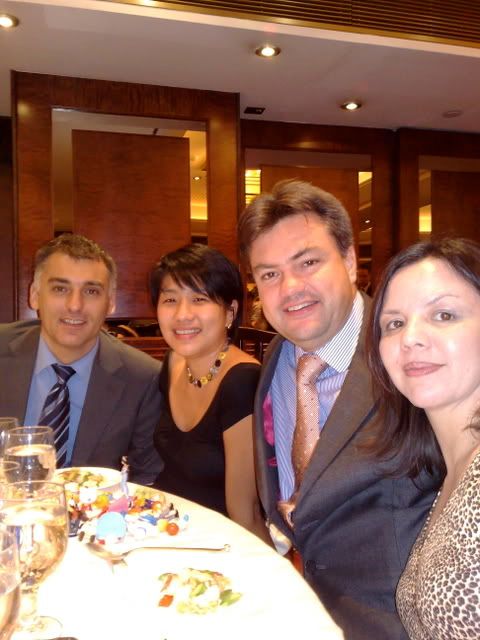
L-R: An ITB French fellow based in China whose name escapes me, Judy Leissner, Edouard and my wife.
The Wines & Food:
2002 Clos Haut-Peyraguey - Paired with Yung Kee’s famous Hundred-Year-Old Egg and (sweetish-tart) Preserved Ginger. At the outset, without having tried it yet, I thought this pairing way too strange.
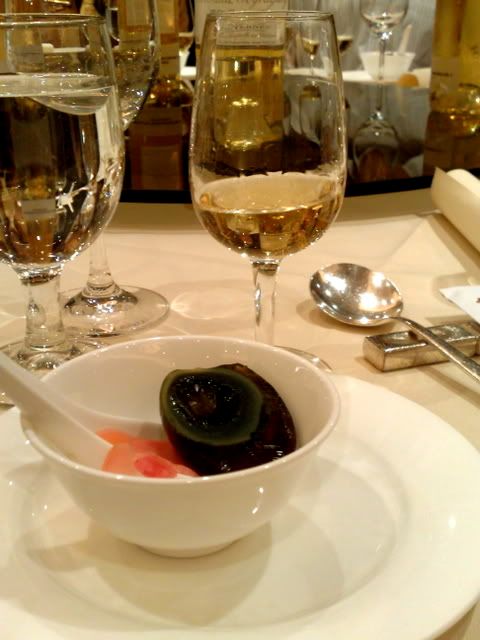
After giving it a try, however, the rich creaminess of the egg’s yolk bound beautifully with the wine’s caramel/candied apricot underbelly, with the sweetness taking over at the finish and the acid keeping the palate from fatigue. I suppose this match parallels pairing foie gras with Sauternes. A revelation for me.
2004 Doisy Daëne - Paired with Fried Sliced Chicken with Ginger and Pineapple.
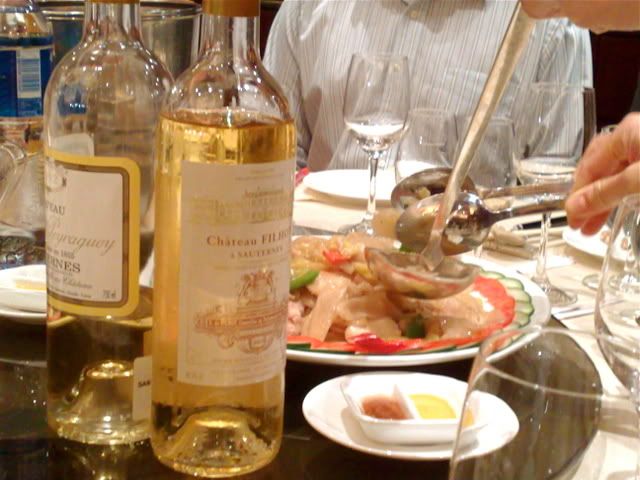
Just reading the ingredients, I could mentally get the pairing: I thought of the ubiquitous Lemon Chicken and Hawaiian Chicken with Pineapple, as well as the preserved ginger and pineapple notes of Sauternes/Barsac wines. I’ve never really been impressed with the wines of Doisy Daëne, generally finding them simple, sweet, shallow though pleasant enough - fluff really, nothing ever serious. That night was no different, I found it charming enough but comparatively superficial and lacking in acidity. I know it’s young though, so it’s not really fair to judge it now.
2001 Suduiraut and 2005 de Rayne Vigeau - Paired with Millenarian Salad á la Hong Hong.
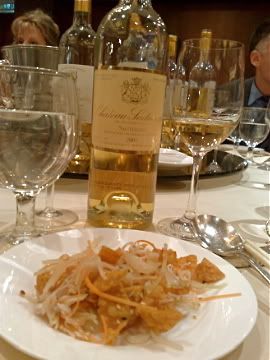
I really didn’t know what to make of the pairing, it was a bit muddled for me (too many things going on with no definite underlying theme or message I could grasp), the wines were both very nice but I felt no real synergy between them and the dish. I must have chosen the wrong wine to pair.
The 2001 Suduiraut was easily the best of the 10 wines (slightly edging over the expansive/voluptuous 1998 Guiraud, the playfully light and complex 2000 Climens and the elegant/floral 1996 Coutet), confidently displaying superior body, weight, authority, depth and length to its delicately spiced dried apricot, ripe peach, orange marmalade and discreet vanilla flavors. My wife astutely summed it all up in the word: “luscious”.
The terribly young 2005 de Rayne Vigeau acquitted itself most adequately, however. I tasted it the day before at the UGC tasting and was pretty impressed, not knowing a thing about it (I do not really experiment with Sauternes and tend to buy only from a handful of châteaux) - consistent with my handwritten notes of the day before:
Elegantly spiced/tangy botrytis notes, nicely perfumed, obviously fuller than the Coutet and better balancing acidity. Good complexity in its girth. Something to look out for.
2000 Climens - Paired with Stir-fried Diced Frog. Again, the pairing’s balance was slanted towards the wine, i.e., I enjoyed the wine more alone rather than (with) the food. The Climens was somewhat similar to the Suduiraut, but playfully lighter and with crisper acidity; admirable complexity/depth/layering on a much lighter frame, and, generally an all-around happy/livelier feel to it.
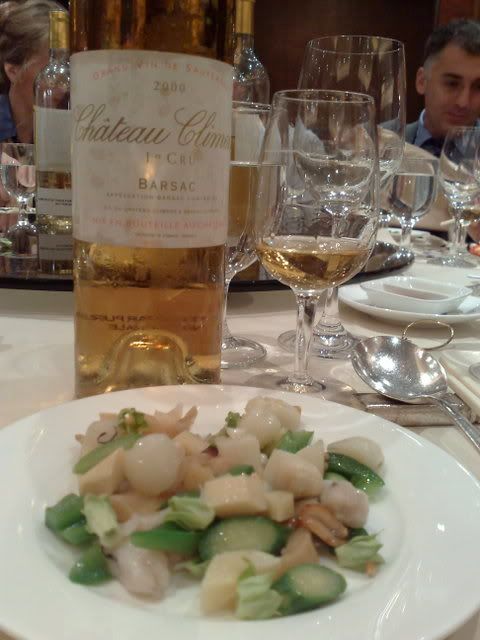
2003 Filhot, 1997 de Myrat and 2001 Suduiraut - With a single, fat, crisp-outside-and-plumply-juicy-inside Deep Fried Oyster.
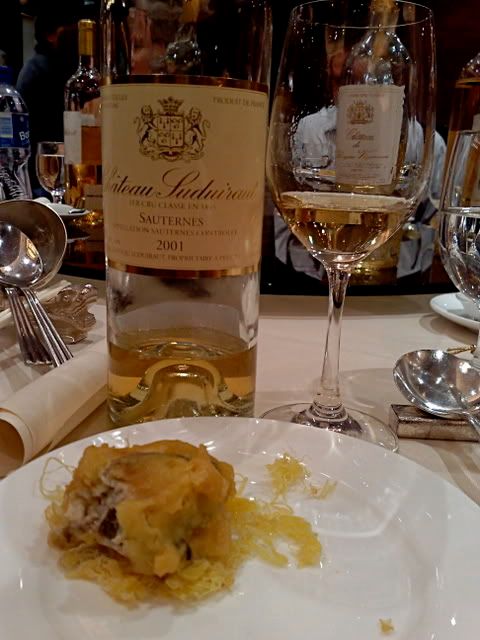
I believe the next two wines (discussed below) were really meant for this dish and not the 2001 Suduiraut, the latter being too rich and big for the dish. I couldn’t help but keep sipping it, though, as I liked it so much.
The 1997 de Myrat’s visage of beautifully deep, amber-gold with an orange ![]() made me expect more body/weight/complexity than it’s light-side-of-medium body and dominant bittersweet orange marmalade back-end displayed. Fair enough of a wine (depending on its price), but I couldn’t help thinking it didn’t live up to its looks.
made me expect more body/weight/complexity than it’s light-side-of-medium body and dominant bittersweet orange marmalade back-end displayed. Fair enough of a wine (depending on its price), but I couldn’t help thinking it didn’t live up to its looks.
The 2003 Filhot, on the other hand, was similar to its Barsac compatriot, Climens, in that it had a notably lithe/brighter/livelier feel to its acidic balance with entertaining lychee whispers over caramel and candied orange rind. Cute wine.
Having said that, I couldn’t quite get the pairing. Shellfish (moreso deep-fried shellfish) makes my palate yearn for a crisp, dry Sancerre blanc or Pouilly-Fumé. My problem, really, but, there it is.
With the the next dish of Smoked Pomfret, I had the 1999 La Tour Blanche and revisited the 2004 Doisy Daëne , together with the Filhot and de Myrat.
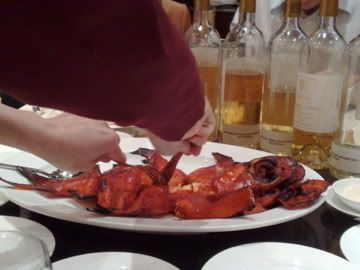
1999 La Tour Blanche - This wine struck a precise balance of peachy/ripe mango sweetness and acidity: lithe, agile, bright, discreetly sweet, with comparable weight to the Doisy Daëne but with much better depth, structure and complexity. I think this paired best with the smoked fish.
With the first bite of the somewhat salty/mildly smoky fish, I figured the one who made the pairing had in mind (and was trying to play off) the traditional salty-sweet combination of Sauternes and roquefort. the dish worked well with the three mentioned lighter/brighter wines. This pairing was also a revelation for me.
With the next dish of Wild Geese Resting on Plum Tree, I had, mainly, the 1998 Guiraud, but also tried it with the 1996 Coutet and, again, the 2001 Suduiraut.
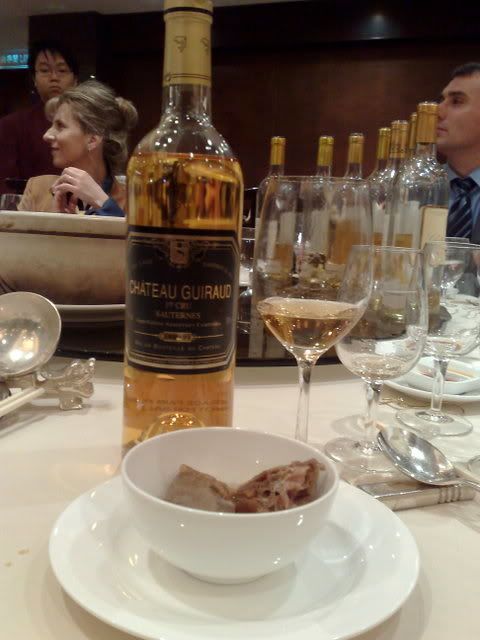
The 1998 Guiraud had structure/weight similar to the 2001 Suduiraut and was expansive (the flavors cloaked and held my palate to great length). It possesses a deep, definitive middle that, together with its aforementioned weight/structure, and its savory orange-rind undertones (beneath its marmalade notes), made it an excellent match with the dish. The 2001 Suduiraut was also an impressive match.
The 1996 Coutet was comparatively lighter on its feet than the Suduiraut and Guiraud, and had a more ethereal/elegant character to it. The Coutet’s definitive authority of flavors certainly, though, rivaled that of the Suduiraut and Guiraud despite the former’s comparatively lighter frame.
I was not much surprised with the fine pairing of Sauternes with Hong Kong-style goose. Goose in Hong Kong is normally served with its own juices and a side of plum sauce. I think this was lightly roasted, then braised in its own juices with a light touch of plum sauce thrown in. The savory and sweet just tied together sublimely.
I continued with the 1996 Coutet with the next dish of Pan-fried Prawn in Shell since the prawn was coated with a thick, sweetish-mildly spiced red sauce.
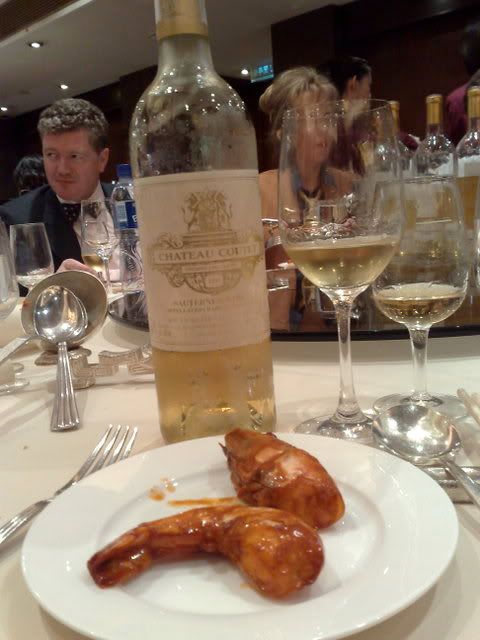
I figured since the prawn wouldn’t be able to take the Suduiraut’s or Guiraud’s size/power and the sauce needed a definitively flavored wine, the Coutet would do nicely. It did indeed (patting myself on the back, I know).
Fried Rice Vermicelli Szechwan Style followed with Sweetened Almond Milk Cream ending the meal nicely, if none too lightly.
We were fortunate enough to be seated at the same table as Suduiraut’s Managing Director, Christian Seely, and his lovely wife, Corinne, and were treated by them to a “bonus” bottle of 1988 Suduiraut which I enjoyed by itself as my dessert. Here they are peeking from behind the '88 as I took their picture.
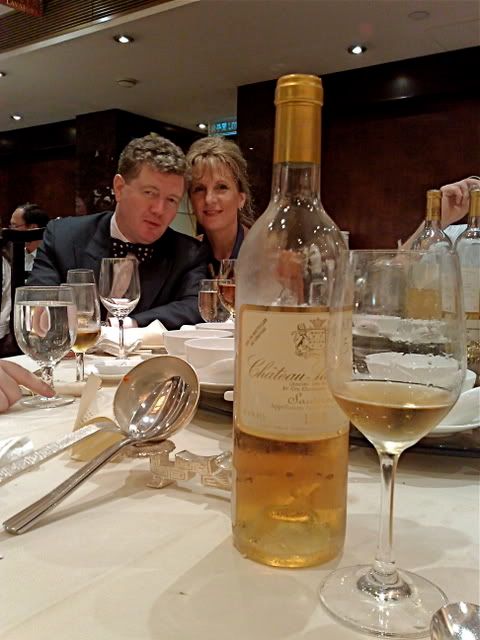
My now alcohol-addled scribbles state:
“Incredibly long, luscious, full/smooth/permeating, orange rind, then sweet apricot, marmalade, orange liqueur, viscuous, layered, harmonious and precisely balanced.”
Sometime in the latter part of the evening, the organizers auctioned off a Sauternes necktie autographed by the various châteaux’s representatives present (Mr. Kinsen Kam, the Yung Kee Group’s owner-Director-General Manager, is on the right). Judy made the opening bid of HK$5000 (approximately US$707) and things escalated after that.
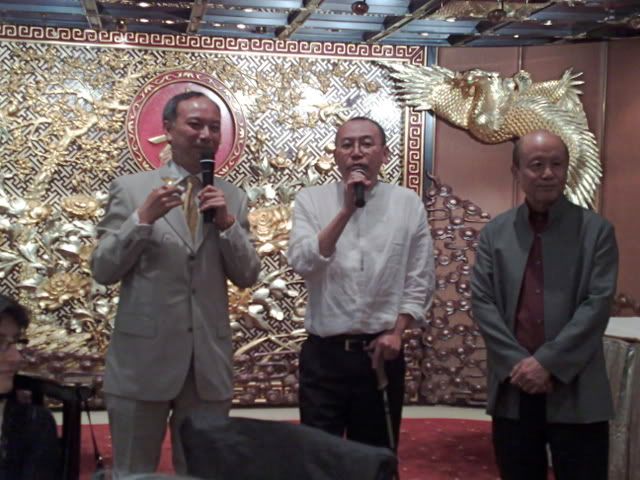
A wine pairing dinner like this could only take place in Hong Kong…
